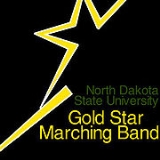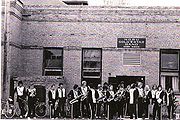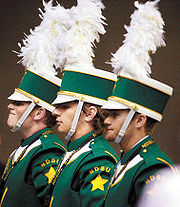
Gold Star Marching Band
Encyclopedia
The Gold Star Marching Band or also known as "The Pride of North Dakota" is the Marching Band
of North Dakota State University
). It is a non-auditioned band (with the exception of the battery section), open to all majors. With approximately 220 members, the band is one of the largest organizations on campus.
Football team in the Fargodome
. The band usually plays 7 shows a year including all home football games and usually one away game, marches the homecoming parade, and does a handful of other performances at NDSU and the Fargo-Moorhead area.
, which in 2009 was updated with brand new field turf. Despite starting band camp with warm temperatures, the band sometimes ends up practicing with snow on the field at the end of the season. The GSMB usually does not regularly practice in the Fargodome, only on game day mornings and days when the dome does not have a prior event.
Once at the dome, the band performs pregame consisting of a field entrance, On Bison fanfare to different sides of the stadium, On Bison
while marching down the field, a patriotic song (Grand Old Flag or Battle Hymn of the Republic), and an adaptation of the North Dakota state song while forming the shape of the star. The band plays the NDSU alma mater The Yellow and The Green
and directly after the song the announcer proclaims "We ARE the Pride of North Dakota" the band then forms "NDSU" while playing Fight Song (We are the Pride)
and forms "BISON" facing the student section side of the dome. The band marches towards the team entrance, forms a tunnel for the team to run out, and plays On Bison as the team runs out. When the lights come back on, the band plays the Star-Spangled Banner, and finally the exits the field.
The band sits in the south endzone directly next to the student section(s). The band then performs a show at halftime, and returns to the stands for the conclusion of the game.
While the band regards the first full year of Doc Putnam’s association with the band (1904) as its “birthday,” student newspaper references indicate a band existed as early as 1901. In fall 1902, Claude Nugent, secretary of the college, and Harry M. Rudd, a local musician, purchased instruments from a local farmer with the intention of creating an NDAC band. Rudd directed the band in some capacity until April 1903 when C.S. Putnam took over.

 Putnam’s leadership was quite dynamic and the band thrived under his direction. This peaked in 1923-24 when the band as an ROTC unit earned its third consecutive 100 percent inspecting rating, which entitled it to a presidential citation and a “Gold Star” rating. Putnam incorporated the moniker into the band’s name and the Gold Star Band was born. Following Putnam’s death in1944, the band’s numbers deteriorated until former Gold Star Band member William Euren became director in 1948. Euren restored the band’s pre-war numbers and worked toward expanding its persona beyond its military role.
Putnam’s leadership was quite dynamic and the band thrived under his direction. This peaked in 1923-24 when the band as an ROTC unit earned its third consecutive 100 percent inspecting rating, which entitled it to a presidential citation and a “Gold Star” rating. Putnam incorporated the moniker into the band’s name and the Gold Star Band was born. Following Putnam’s death in1944, the band’s numbers deteriorated until former Gold Star Band member William Euren became director in 1948. Euren restored the band’s pre-war numbers and worked toward expanding its persona beyond its military role.
Euren retired in 1968, and Roger Sorenson became director of bands for two years before leaving in 1970. During his brief tenure, Sorenson engendered a level of lasting loyalty among alumni who performed under his direction. Orville Eidem arrived in 1970 and was director of bands for the next 23 years. Besides the perpetuation of the marching band tradition, Eidem also had a great love of jazz and expanded the scope of NDSU’s program. The band also played a role in lobbying efforts for a new facility. Reineke Fine Arts Center replaced Putnam Hall and the old Festival Hall in 1981.
Several other names have been associated with the band. While C.S. Putnam was away from the band in 1914-17, Harold Bachman and B.A. Orr were directors. Edward D. Schroepfer directed the band following Putnam’s death. Roy Johnson also played a significant role in the band’s musical leadership during the Sorenson years.
 Orville Eidem retired in 1993, at which time Wayne F. Dorothy became the new director. Dorothy was previously Assistant Director of Bands under Eidem. Then in 1999, Dorothy retired and was replaced by Warren Olfert as director of bands.
Orville Eidem retired in 1993, at which time Wayne F. Dorothy became the new director. Dorothy was previously Assistant Director of Bands under Eidem. Then in 1999, Dorothy retired and was replaced by Warren Olfert as director of bands.
2007 was a year for changes when Dr. Sigurd Johnson was hired as the newly created Athletics Band director leading the marching band and pep band. For the 2008 season, the band received new uniforms, recovered gold drums, and the addition of a front ensemble (pit). The GSMB is currently growing and is evident in the growth of the band from 83 in 2007, to 163 in 2008, to 185 in 2009, and to 220 in 2010.
".
. Rookies are required to learn the SATB parts quickly, or they will have to sing it by themselves at the ending band banquet.
The band also performs the Sounds of the Gridiron concert at the end of the season. All of the halftime shows, the pregame, and some of the stands music are all performed.
Marching band
Marching band is a physical activity in which a group of instrumental musicians generally perform outdoors and incorporate some type of marching with their musical performance. Instrumentation typically includes brass, woodwinds, and percussion instruments...
of North Dakota State University
North Dakota State University
North Dakota State University of Agriculture and Applied Sciences, more commonly known as North Dakota State University , is a public university in Fargo, North Dakota. NDSU has about 14,000 students and it is the largest university in North Dakota based on full time students and land size...
). It is a non-auditioned band (with the exception of the battery section), open to all majors. With approximately 220 members, the band is one of the largest organizations on campus.
About the GSMB
The GSMB does pregame and halftime performances for the NDSU BisonNorth Dakota State Bison football
The North Dakota State Bison football program represents North Dakota State University in college football at the NCAA Division I Football Championship Subdivision level and competes in the Missouri Valley Football Conference. From 2004 to 2007, the Bison were members of the Great West Football...
Football team in the Fargodome
Fargodome
The Fargodome is an indoor stadium, located in Fargo, North Dakota. It opened in 1992 and holds over 19,000 people for football games and over 25,000, for full arena concerts....
. The band usually plays 7 shows a year including all home football games and usually one away game, marches the homecoming parade, and does a handful of other performances at NDSU and the Fargo-Moorhead area.
Rehearsal
The GSMB practices Monday, Wednesday, and Fridays from 4:00-5:45pm, and Saturday morning rehearsals on game days. The band practices indoors in the music building of the Reineke Fine Arts Center. Outdoors, the band practices either on the football practice field, or Dacotah FieldDacotah Field
Dacotah Field is the former home of the North Dakota State University football team. It is located in Fargo, North Dakota, United States. It opened in 1910 and held 13,000 people. It was replaced by the Fargodome when it opened in 1992.-External links:*...
, which in 2009 was updated with brand new field turf. Despite starting band camp with warm temperatures, the band sometimes ends up practicing with snow on the field at the end of the season. The GSMB usually does not regularly practice in the Fargodome, only on game day mornings and days when the dome does not have a prior event.
Game Day
Game Day for the band starts with morning rehearsal at the Fargodome. After morning rehearsal the band has a later call time to be in the band room of the music building. At call, all sections are accounted for and uniforms inspected. The band then goes outside to start the march over. The march over is a seven or so block parade-style march from the music building, through the NDSU campus, up to the Fargodome.Once at the dome, the band performs pregame consisting of a field entrance, On Bison fanfare to different sides of the stadium, On Bison
On Bison
On Bison is a fight song of North Dakota State University in Fargo, North Dakota.-Lyrics:...
while marching down the field, a patriotic song (Grand Old Flag or Battle Hymn of the Republic), and an adaptation of the North Dakota state song while forming the shape of the star. The band plays the NDSU alma mater The Yellow and The Green
The Yellow and The Green
The Yellow and The Green is the Alma Mater of North Dakota State University in Fargo, North Dakota. The Yellow and The Green was written by a young North Dakota Agricultural College faculty member, Archibald E. Minard, in 1908. Minard later took the lyrics to Dr. Clarence S...
and directly after the song the announcer proclaims "We ARE the Pride of North Dakota" the band then forms "NDSU" while playing Fight Song (We are the Pride)
We are the Pride
We are the Pride is a fight song of North Dakota State University in Fargo, North Dakota.-Lyrics:Verse:We are the Pride is a fight song of North Dakota State University in Fargo, North Dakota.-Lyrics:Verse:...
and forms "BISON" facing the student section side of the dome. The band marches towards the team entrance, forms a tunnel for the team to run out, and plays On Bison as the team runs out. When the lights come back on, the band plays the Star-Spangled Banner, and finally the exits the field.
The band sits in the south endzone directly next to the student section(s). The band then performs a show at halftime, and returns to the stands for the conclusion of the game.
Instrumentation
The Gold Star Marching Band (GSMB) currently includes:- 3 Drum Majors
- Baton Twirlers
- Flutes/Piccolos
- Clarinets
- Alto Saxophones
- Tenor Saxophones
- Mellophones
- Trumpets
- Trombones
- Baritones
- Sousaphones
- Cymbals
- Snare Drums
- Tenor Drums
- Bass Drums
- Front Ensemble (Pit)
- Color Guard
History
The Gold Star Band owes much of its existence to a personal tragedy. In spring 1903, Clarence Simeon Putnam, a local Fargo doctor, watched his downtown Fargo medical practice burn to the ground – five days after his insurance had lapsed. Essentially out of a job, Putnam landed a position teaching arithmetic at North Dakota Agricultural College. While the next set of events is not entirely clear, a need arose for leadership of NDAC’s ROTC band. Putnam, a cornetist, found himself in charge of 14 members known as the “Cadet Band” on April 14, 1903.While the band regards the first full year of Doc Putnam’s association with the band (1904) as its “birthday,” student newspaper references indicate a band existed as early as 1901. In fall 1902, Claude Nugent, secretary of the college, and Harry M. Rudd, a local musician, purchased instruments from a local farmer with the intention of creating an NDAC band. Rudd directed the band in some capacity until April 1903 when C.S. Putnam took over.


Euren retired in 1968, and Roger Sorenson became director of bands for two years before leaving in 1970. During his brief tenure, Sorenson engendered a level of lasting loyalty among alumni who performed under his direction. Orville Eidem arrived in 1970 and was director of bands for the next 23 years. Besides the perpetuation of the marching band tradition, Eidem also had a great love of jazz and expanded the scope of NDSU’s program. The band also played a role in lobbying efforts for a new facility. Reineke Fine Arts Center replaced Putnam Hall and the old Festival Hall in 1981.
Several other names have been associated with the band. While C.S. Putnam was away from the band in 1914-17, Harold Bachman and B.A. Orr were directors. Edward D. Schroepfer directed the band following Putnam’s death. Roy Johnson also played a significant role in the band’s musical leadership during the Sorenson years.

2007 was a year for changes when Dr. Sigurd Johnson was hired as the newly created Athletics Band director leading the marching band and pep band. For the 2008 season, the band received new uniforms, recovered gold drums, and the addition of a front ensemble (pit). The GSMB is currently growing and is evident in the growth of the band from 83 in 2007, to 163 in 2008, to 185 in 2009, and to 220 in 2010.
March Over
The march over is a parade-like march through the NDSU campus. It starts from the music building, up Albrecht Boulevard through campus, and around the front entrance to the Fargodome. Once at the dome, the band splits into three bands and performs for tailgators in the west dome lot, for the president's reception, and for fans in front of the Fargodome. The band joins together and enters the Fargodome from the north ramp of the dome. The march over is known for its various hijinks including chants, random line follow the leader, section swapping of instruments, dances, and stop-sign slapping. In the past there used to be a night march over every year in which the band would wear glow sticks and lights in the twilight of a fall game night.In Heaven
After a Bison victory in a football, basketball, or volleyball game; the band performs the traditional playing and singing of all 5 verses of "In Heaven there is no BeerIn Heaven There is No Beer
In Heaven There Is No Beer is a song about the existential pleasures of beer drinking. The title of the song is the reason to drink beer while you are still alive.The song in German is "Im Himmel gibt's kein Bier", in Spanish, "En El Cielo No Hay Cerveza"....
".
The Yellow and the Green
Every time the Gold Star Marching Band has a group meal together, the president of the band will ask the band to stand and sing the NDSU alma mater, the Yellow and the GreenThe Yellow and The Green
The Yellow and The Green is the Alma Mater of North Dakota State University in Fargo, North Dakota. The Yellow and The Green was written by a young North Dakota Agricultural College faculty member, Archibald E. Minard, in 1908. Minard later took the lyrics to Dr. Clarence S...
. Rookies are required to learn the SATB parts quickly, or they will have to sing it by themselves at the ending band banquet.
Band Banquet and Concert
The Band always holds a band banquet towards the end of the year for the graduating/exiting members. Different awards are given out like, Section of the Year, Rookie of the Year, and section awards like the green trumpet (member to member), pink lightning (the formerly pink trombone for the rookie trombone player), and the black trombone (member to member).The band also performs the Sounds of the Gridiron concert at the end of the season. All of the halftime shows, the pregame, and some of the stands music are all performed.

